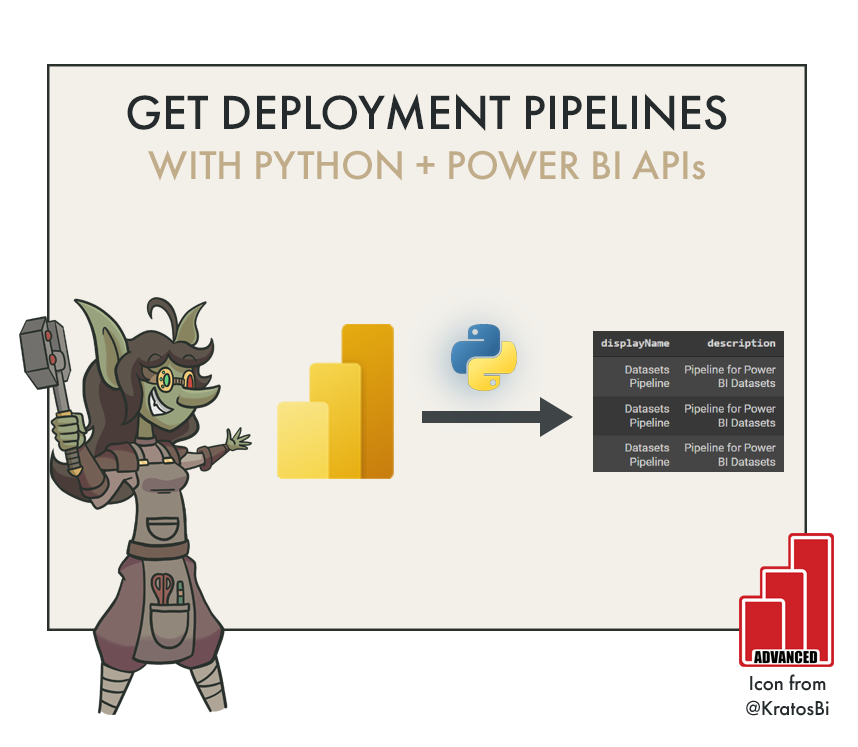Get Deployment Pipelines from Power BI API with Python
USE PYTHON TO GET DATA FROM POWER BI APIs
…such as the deployment pipelines a user or service principle has access to
IN THIS ARTICLE
Get Deployment Pipelines from Power BI Admin API using Python
Example result dataframe for deployment pipelines obtained with the Admin API
HOW TO SET IT UP?
I wrote a post about setting up a Service Principal, permissions & settings to get you started, as well as explaining the Authentication. You can find that post, here.
#########################################################################################
# Authentication - Replace string variables with your relevant values
#########################################################################################
import json, requests, pandas as pd
try:
from azure.identity import ClientSecretCredential
except Exception:
!pip install azure.identity
from azure.identity import ClientSecretCredential
# --------------------------------------------------------------------------------------#
# String variables: Replace with your own
tenant = 'Your-Tenant-ID'
client = 'Your-App-Client-ID'
client_secret = 'Your-Client-Secret-Value' # See Note 2: Better to use key vault
api = 'https://analysis.windows.net/powerbi/api/.default'
# --------------------------------------------------------------------------------------#
# Generates the access token for the Service Principal
auth = ClientSecretCredential(authority = 'https://login.microsoftonline.com/',
tenant_id = tenant,
client_id = client,
client_secret = client_secret)
access_token = auth.get_token(api)
access_token = access_token.token
print('
Successfully authenticated.')
#########################################################################################
# Note 1: This code was authored for use in a Google Colab Notebook
# Note 2: Check here for info on using Azure Key Vault:
# https://docs.microsoft.com/en-us/azure/key-vault/secrets/quick-create-python
# The above code should be modified to programmatically get the secret from AKV
#########################################################################################
# Admin: Get all Deployment Pipelines
#########################################################################################
base_url = 'https://api.powerbi.com/v1.0/myorg/'
header = {'Authorization': f'Bearer {access_token}'}
# The admin API doesn't work unless you provide a ?$top=n argument
# Top 5000 pipelines
topn = '$top=5000'
# All pipelines, no expand
admin_pipelines = f'{base_url}admin/pipelines?{topn}'
# All pipelines with users & stages
admin_pipelines_expand = f'{base_url}admin/pipelines?$expand=users,stages&{topn}'
# HTTP GET Request
pipelines = requests.get(admin_pipelines_expand, headers=header)
# Response code (200 = Success; 401 = Unauthorized; 404 = Bad Request)
print(pipelines)
try:
pipelines = json.loads(pipelines.content)
# Pretty-prints the JSON
print(json.dumps(pipelines, indent=4,
sort_keys=True))
except Exception as e:
print(e)
#########################################################################################
# Custom function to flatten the dataframe containing nested json / list objects
#########################################################################################
# Reference: https://stackoverflow.com/a/61269285
def flatten_nested_json_df(df):
df = df.reset_index()
# search for columns to explode/flatten
s = (df.applymap(type) == list).all()
list_columns = s[s].index.tolist()
s = (df.applymap(type) == dict).all()
dict_columns = s[s].index.tolist()
while len(list_columns) > 0 or len(dict_columns) > 0:
new_columns = []
for col in dict_columns:
horiz_exploded = pd.json_normalize(df[col]).add_prefix(f'{col}.')
horiz_exploded.index = df.index
df = pd.concat([df, horiz_exploded], axis=1).drop(columns=[col])
new_columns.extend(horiz_exploded.columns) # inplace
for col in list_columns:
# explode lists vertically, adding new columns
df = df.drop(columns=[col]).join(df[col].explode().to_frame())
new_columns.append(col)
# check if there are still dict o list fields to flatten
s = (df[new_columns].applymap(type) == list).all()
list_columns = s[s].index.tolist()
s = (df[new_columns].applymap(type) == dict).all()
dict_columns = s[s].index.tolist()
return df
#########################################################################################
# Return the result in a dataframe
#########################################################################################
result = flatten_nested_json_df(pd.concat([pd.json_normalize(x) for x in pipelines['value']])).reset_index(drop=True)
result
Code is provided as-is with no guarantees or warranties of any kind. Something I did quickly in spare time.





